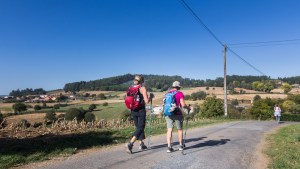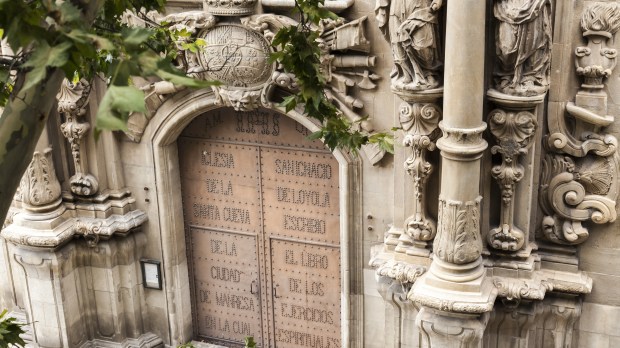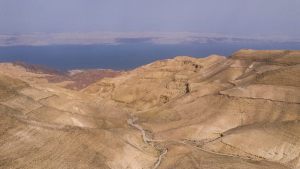Christian traditions have read the biblical Fall of Adam and Eve as portraying human beings as exiles, in an often-inhospitable world, estranged from God and from one another. Later biblical narratives and Christian commentaries highlight this being exiled as a constitutive attribute of human existence.
In fact, exile is constant throughout the Hebrew Bible. Abraham and his descendants go from one exile to the other: Egypt, the desert, Babylon. But pilgrimage is also prominent in most of these narratives: pilgrimages are, both metaphorically and spiritually, ways to undo said exile, a means of going “back home.”
All New Testament writers highlight the inevitable transience of this world (Cf Jn 2:17; 1 Cor 7:31; or James 1:11), encouraging believers to understand themselves as “pilgrims and strangers on the earth” or “temporary residents” whose true home is to be found in heaven (1 Peter 2:11; Hebrews 11:13). These texts have helped perceive Christian life as a journey towards that homeland — thus giving Christian pilgrimage a distinctive inward-and-outward dimension.
The Ignatian Camino
The Ignatian Camino is a pilgrimage road that goes from Azpeitia, the native town of St. Ignatius of Loyola, to Manresa, following the steps of the popular Basque saint. As this road grew in popularity, it ended up earning a place of its own among other, more famous pilgrimage routes in Europe, such as the Camino de Santiago and the Via Francigena.
Chris Lowney, a one-time Jesuit seminarian, is co-author of the Guide to the Camino Ignaciano, the official guide to the route (the other co-author being Fr. Jose Luis Iriberri, S.J). Lowney’s other books include the bestselling Heroic Leadership, which has been translated into 11 languages. Aleteia had the opportunity of interviewing Lowney regarding this exceptional pilgrimage route.
Most people, when they think of a Camino, think only of the Way of Saint James, the Camino de Compostela. However, Christianity abounds with pilgrimage routes. What would you say is the main, distinctive trace of the Ignatian Camino?
The Ignatian Camino is unique in many powerful ways. To begin with, it traces a life-changing trek that was undertaken by a saint, Ignatius of Loyola. Many other pilgrimages may visit a place where a saint’s remains are interred (like the Camino de Santiago), but in the case of the Ignatian Camino, you are tracing the very footsteps of Ignatius, visiting many of the same places he visited along the way, experiencing some of the very landscapes and shrines that deeply moved him.

Here’s something else: many readers will know of the Spiritual Exercises of Ignatius, probably the most widely used retreat guide in the Catholic world. Ignatius formed the rudiments of these Exercises during this very trek.We encourage pilgrims to do these Exercises as they trek, along the route where they took shape in Ignatius’s heart and mind.
Where does it start, and where does it end? I’m asking because, for some, the Ignatian Way should end in Manresa. Others seem to claim it should lead all the way to Jerusalem, through Barcelona.
That’s a great question. The first iteration of the Camino began in Loyola, where Ignatius was born, and where he recuperated after his life-changing battle injury. The Camino ends in Montserrat and Manresa, the places where Ignatius had profound spiritual and mystical insights.
But let me complicate what I just told you, in answer to your question! An “extension” of the Camino has just been plotted out, so pilgrims can now continue from Manresa all the way into Barcelona, which is what Ignatius himself did. And, in fact, Barcelona is another city that is filled with sites and markers from Ignatius’s life.
All the way to Jerusalem? Well, not yet! But you are right: Ignatius’ own journey of self-discovery continued from Barcelona on to the Holy Land.
One of the most interesting places of the Ignatian Camino, in my opinion, is in Santa María del Mar, in Barcelona, which you just mentioned. There, one finds the steps in which Ignacio used to sit to beg for money to pay for his studies. Is there a stop in the Camino that you prefer?
I don’t think I could pick one spot, so I’ll name a few. Loyola, his birthplace, because of the mountainous beauty of Spain’ Basque country. Los Monegros would be another favorite, but a very strange choice, I admit! This region is the closest thing in Europe to a desert, and very, very sparsely populated. It’s almost forbidding, but, in an odd way, whenever I pass through it, even in a car, I always feel close to Ignatius, imagining this small, 16th-century man struggling through this barren landscape. It says something about his perseverance, and I always wonder what was going on in his mind in this region. Montserrat is a special place when the tourist busses are not there! Early in the morning and late at night, you can have it to yourself, as it must have felt to Ignatius: he laid down his sword here during an all-night vigil.

I have already cheated by naming three places, not the one you asked for, so I’ll stop, even though I could name one or two more!
Can you share a few words about Ignatian spirituality, and on the ways in which pilgrimaging plays a part in it?
I mentioned the Spiritual Exercises, which are in some ways the root of Ignatius’ distinctive spirituality. One could point to several of its elements, but I’ll just pluck out a few. One mantra of Ignatian spirituality is “finding God in all things”: he has a powerful sense, which he passes on to us, of the presence of God in all the people and situations we encounter. And he constantly emphasizes a spirit of “discernment.” It’s no surprise that Pope Francis, who is also a Jesuit, talks about discernment a lot. To oversimplify that idea, I would say that Ignatius understands God’s Spirit is constantly talking to us, guiding us in our important life choices, like who to marry and what job to take. We just need to learn how to “listen” to the ways in which God guides us, which is not as easy as dialing a telephone number and getting an answer from God.
The last point, as you mention pilgrimage in your question: when he related his life story, Ignatius called himself “a pilgrim.” Clearly, as many other Christian writers have shared, Ignatius understands life as pilgrimage: we are journeying through this world on the way to God. Or, better put, we are journeying to God, but also with God alongside us in Jesus.
One of the distinctive elements of Ignatian Spirituality is the Composición de Lugar, the famous Composition of Place, an imaginative contemplation of sorts to help the mind focus during prayer. Would you say pilgrimage helps contemplation? Does walking through this path (and contemplating the impressive landscapes of northern Spain) have something to do with it?
For me personally, there are two important ways in which pilgrimage helps me to be open in prayer. One way I would describe, with a bit of humor, as boredom. But I don’t really mean it that way. I’ve never been bored while trekking on a pilgrimage. But I would say this: When you are walking for five, six, or eight hours in a day, without a telephone or business meetings to distract you, your mind really frees up. You think about your past, you daydream, you get transported beyond the things that typically distract and fill our days. So, I’ve always thought that, while on pilgrimage, God is patiently waiting while we clear away all the debris in our heads, and, eventually, whether out of sheer boredom or grace, we end up mulling some of those important considerations that we haven’t thought about a lot or haven’t thought about in a long time.
Here’s a second way in which I’ve always found pilgrimage helpful: you get pushed way out of your comfort zone, and whether it is in sports, or university classes, or anything else in life, I think we often do some of our deepest learning when we get pushed outside our comfort zone. What do I mean by “comfort zone”? It could be anything, and it is probably different for each of us. One of us becomes afraid of getting lost or ending up outside in the dark; another of us can’t stand the prospect of being alone with one’s thoughts all day; someone else becomes exhausted or has blisters and gets a bit broken open inside.



